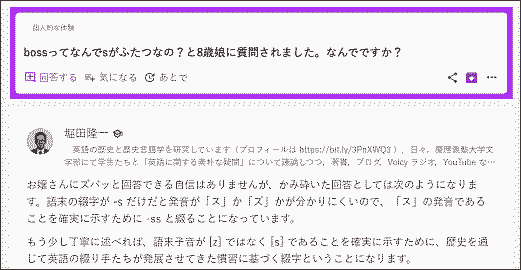2024-03-14 Thu
■ #5435. 仮名の濁点と英語摩擦音3対の関係 [syllable][phonology][grammatology][hiragana][japanese][writing][diacritical_mark][phonetics][consonant][fricative][th][mond][helwa]
現代日本語の慣習によれば,平仮名の「か」に対して「が」,「さ」にたいして「ざ」,「た」に対して「だ」のように濁音には濁点が付される.阻害音について,清音に対して濁音ヴァージョンを明示するための発音区別符(号) (diacritical_mark) だ.ハ行子音を例外として,原則として無声音に対して有声音を明示するための記号といえる.濁点のこの使用方針はほぼ一貫しており,体系的である.
一方,英語の摩擦音3対 [f]/[v], [s]/[z], [θ]/[ð] については,正書法上どのような書き分けがなされているだろうか.この問題については,1ヶ月ほど前に Mond に寄せられた目の覚めるような質問を受け,それへの回答のなかで部分的に議論した.
・ boss ってなんで s がふたつなの?と8歳娘に質問されました.なんでですか?

[f] と [v] については,それぞれ <f> と <v> で綴られるのが大原則であり,ほぼ一貫している.of [əv] のような語はあるが,きわめて例外的だ.
[s] と [z] の書き分けに関しては,上記の回答でも,かなり厄介な問題であることを指摘した.<s>, <ss>, <se>, <ce>; <z>, <zz>, <ze> などの綴字が複雑に絡み合ってくるのだ.なるべく書き分けたいという風味はあるが,そこに一貫性があるとは言いがたい.
[θ] と [ð] に至っては,いずれも <th> という1種類の綴字で書き表わされ,書き分ける術はない.歴史的にいえば,書き分けようという意図も努力も感じられなかったとすらいえる.
以上より序列をつければ,
・ 仮名の濁点を利用した書き分けは「トップ合格」
・ [f]/[v] の書き分けは「合格」
・ [s]/[z] の書き分けは「ギリギリ及第」
・ [θ]/[ð] の書き分けは「落第」
となる.この序列づけのインスピレーションを与えてくれたのは Daniels (64) の次の1文である,
Phonemic split sometimes brings new letters or spellings (e.g. Middle English <v> alongside <f> when French loans caused voicing to become significant; cf. also <vision> vs <mission>), sometimes not---English used <ð> and <þ> indifferently, even in a single manuscript, for both the voiced and voiceless interdentals, a situation persisting with Modern English <th> due to low functional load. Japanese, on the other hand, uses diacritics on certain kana for the same purpose.
なお,今回の話題については,先行して Voicy のプレミアムリスナー限定配信チャンネル「英語史の輪」 (helwa) の配信回「【英語史の輪 #95】boss ってなんで s が2つなの?」(2月17日配信)で取り上げている.
・ Daniels, Peter T. "The History of Writing as a History of Linguistics." Chapter 2 of The Oxford Handbook of the History of Linguistics. Ed. Keith Allan. Oxford: OUP, 2013. 53--69.
2022-02-04 Fri
■ #4666. 世界英語で扱いにくい th-sound [fricative][phonetics][phonology][world_englishes][th]
英語の th-sound が,通言語的に厄介な発音であることは「#842. th-sound はまれな発音か」 ([2011-08-17-1]) その他で見てきた.標準英語においては th-sound と称される歯摩擦音 [θ, ð] は,歯茎破裂音 [t, d] とも歯茎摩擦音 [s, z] とも唇歯摩擦音 [f, v] とも異なる子音であり,独立した音素を構成している.しかし,多くの言語ではこの英語の th-sound を独立した音素としてもっていないため,英語を話す際には別の子音で代替するなど何らかの対処法が必要となる.
これは世界英語の文脈では厄介な問題となり得る.例えば,日本語では th-sound は「ス」あるいは「ズ」として取り入れることが基本となっているが,そうすると s/z との区別がつかない.かくして,「スィング」は sing にも thing にも対応することになり,「ゼン」は Zen にも then にも対応するという,困った事態となる.
これは,日本語だけではなく世界中の言語で広く観察される問題である.多くの言語が,この子音を受容するに当たって悩んでいるのだ.Mesthrie and Bhatt (126--27) は,th-sound の世界的受容について次のように記述している.
Fricatives: The most striking feature among fricatives is that all New Englishes varieties treat /θ/ and /ð/ as something other than an interdental fricative. /θ ð/ are realised similarly as a pair as follows:
Dental stops [t̪ d̪] in CFl [= Cape Flats] Eng (variably) and regularly in IndSAf Eng, Pak Eng;
An aspirated dental stop [t̪h] occurs widely in Ind Eng, but its voice counterpart [d̪] is not usually aspirated;
Alveolar stops [t d] in EAf Eng, Ghan Eng, Sgp Eng, Mal Eng, Phl Eng;
Variably as [t t̪] for /θ/ and [d d̪] for /ð/ in BlSAf Eng and Ghan Eng;
Affricate realisations [t θ] and [d ð] are reported as lesser variants in Ghan Eng.
/θ/ is realised as [f] word-finally in some words in EAf Eng, Ghan Eng and Sgp Engl
In EAfr Eng /θ/ and /ð/ may be realised as [t s f] and [d z v] respectively, Other changes to fricatives are less widespread;
東アフリカ英語変種を中心として,多くの変種において th-sound は,標準英語と同じように調音されていないことがわかるだろう.
・ Mesthrie, Rajend and Rakesh M. Bhatt. World Englishes: The Study of New Linguistic Varieties. Cambridge: CUP, 2008.
Powered by WinChalow1.0rc4 based on chalow